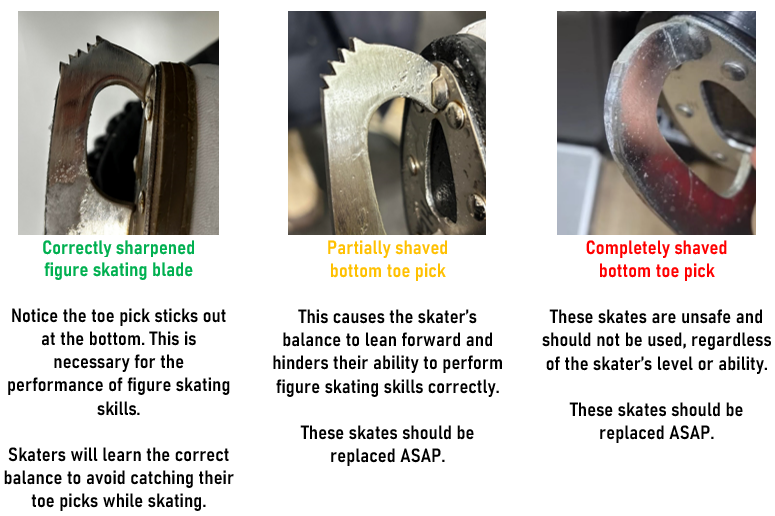This section is a global section that will be seen on all pages
Equipment Requirements & Recommendations
Proper equipment will ensure your child gets the best chance to succeed in our programs. Improperly fitting skates or helmets can be uncomfortable and obstructive to their learning and success.
Click for each program's required equipment:
Skate Fitting & Care Of Skates
Proper equipment will ensure your child gets the best chance to succeed in our programs. Improperly fitting skates or helmets can be uncomfortable and obstructive to their learning and success.
Skate Fitting
Properly fitting skates are crucial for comfort, performance, and injury prevention. A good fit should be snug, but not painful, with no heel lift. Here is a step-by-step guide on how to fit skates.
- Start with the Right Socks - Wear the same socks you plan to skate in. It is generally recommended to wear thin socks or tights, as thick socks can create bulk and lead to blisters by allowing your foot to move around.
- Loosen and Insert Foot - Unlace the skates all the way down and pull the tongue forward to easily slide your foot in. While seated, push your foot firmly back into the heel pocket of the boot. Your toes should barely touch or lightly brush the toe cap.
- Check the Length - With your heel firmly in place and the skates unlaced, you can check for proper length. For adults, your toes should just brush the end of the boot. For children, you should be able to fit a single index finger between their heel and the back of the boot to allow for some growth. More than a finger's width means the skate is too big and can cause instability and blisters.
- Lace Up and Stand - Lace the skates from the bottom up, maintaining even tension. The lacing should be snug, but not so tight that it causes pain. The laces should not be so far apart that they barely cover the tongue, nor should they be so close together that they're pinching the boot. Once laced, stand up and bend your knees into a skating stance. Your toes should pull back slightly from the end of the boot.
- Check for Heel Lift - This is the most critical part of the fitting process. When you bend your knees and try to lift your heel, there should be little to no movement. If your heel lifts significantly inside the boot, the skates are too big and will compromise your control and support.
Care of Skates
- Dry blades with a soft cloth immediately after use.
- Store skates with blades uncovered, or covered with a soft fabric skate blade cover.
- To protect your blades, ALWAYS wear hard plastic skate guards when walking off the ice.
Skate Sharpening
- Skates should be sharpened when purchased and after approximately every 10 hours of skating. Sharpen skates more often if they have been used on outdoor ice.
- Take care to ensure the bottom toe pick is NOT removed by the sharpener. It is part of the design of figure skates and it is used for performance of some skills and is essential to proper balance.
- Figure skates should be sharpened by shops that are specifically trained to sharpen figure skates. The shape of a figure skate blade is vastly different to a hockey skate blade. This is especially important as the skater advances through our programs.
- We recommend getting figure skates sharpened at Professional Skate on 42 Avenue SE or The Skate Lab on MacLeod Trail.

